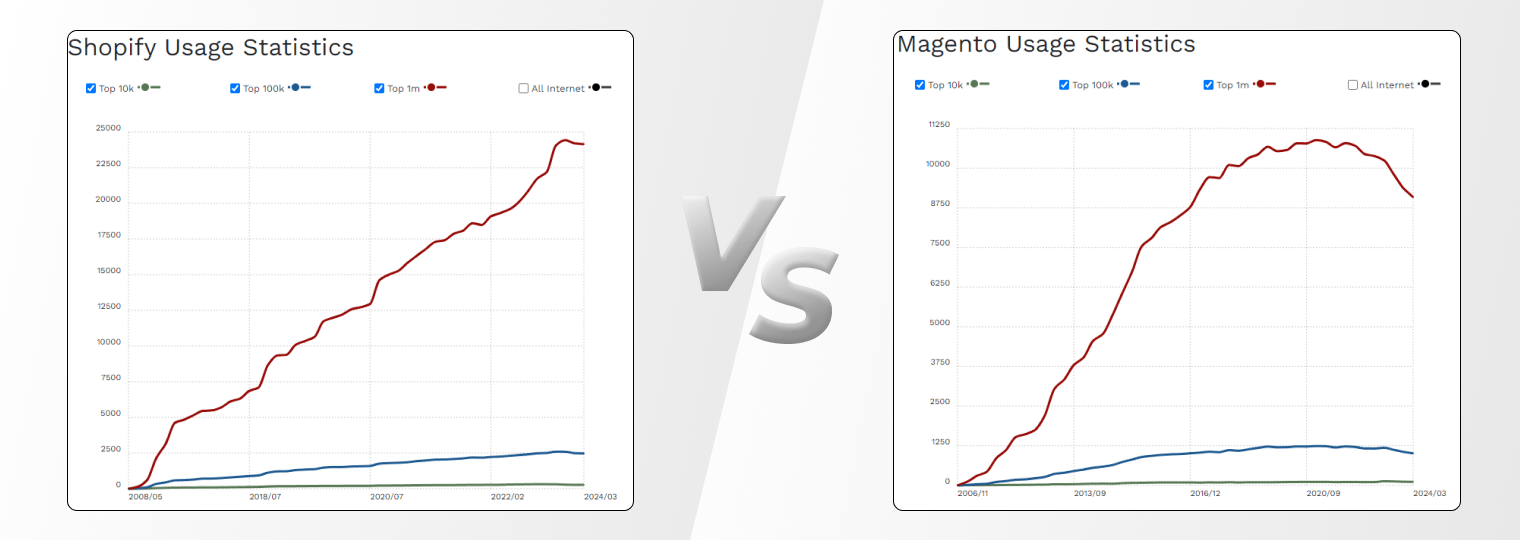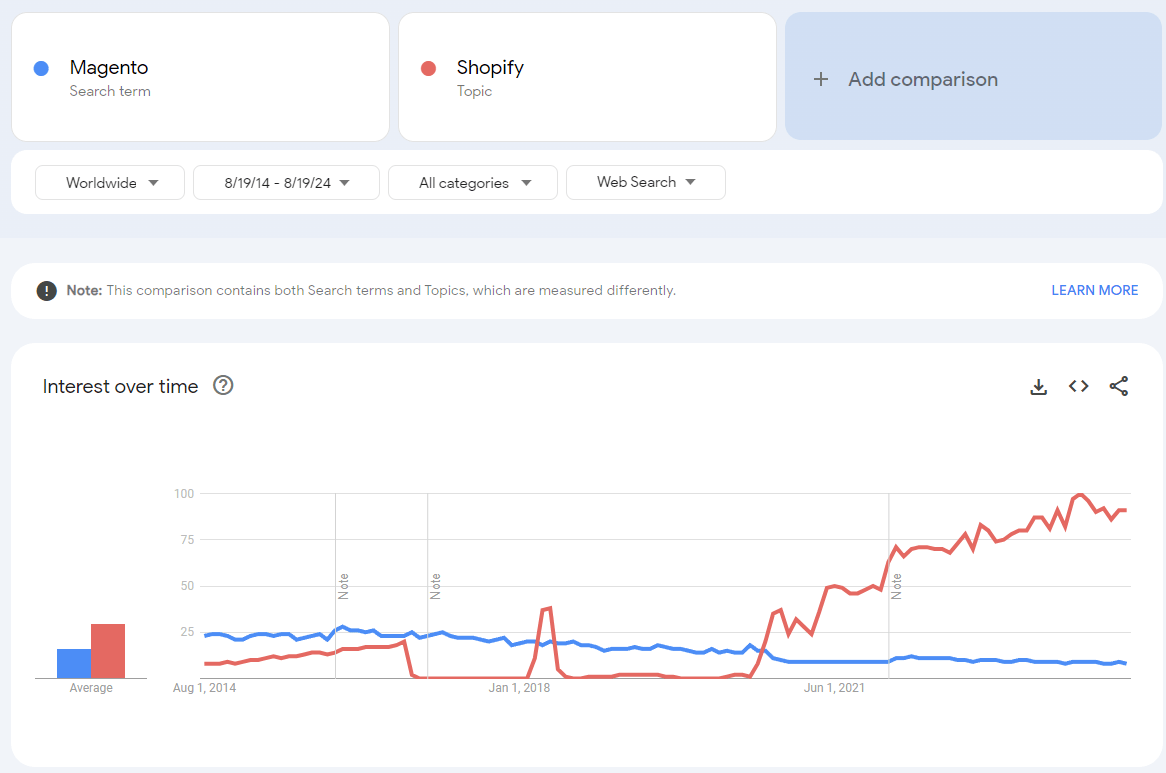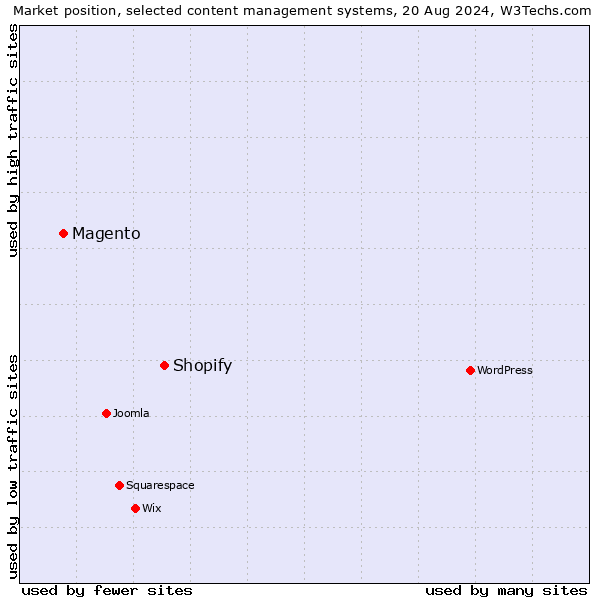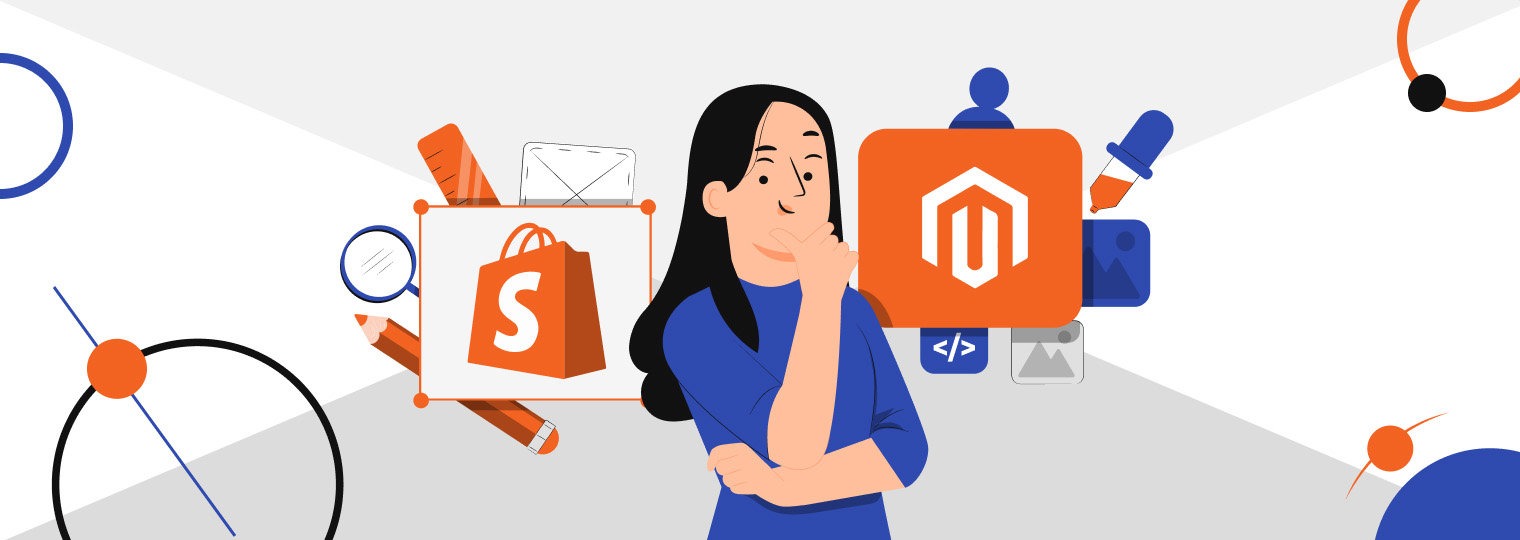Today’s eCommerce space is evolving at lightning speed. Remember, there are thousands of eCommerce businesses like yours that ponder upon it.
As a business owner, if you want to survive in the digital age, sooner or later, you’ll need to bring your products online, and you’ll need the right eCommerce platform. In a tech-driven world, a compact and robust eCommerce platform helps you maintain a professional store.
Plus, it makes it easier to showcase your product line, ensure an impeccable shopping experience, and count a significant uptick in sales. Moreover, eCommerce platforms have centralized the efforts of businesses managing their inventory, offering customer support, and processing payments.
- Magento vs Shopify: Which Platform to Choose for Your Store? A Business Comparison
- Magento vs Shopify: Numbers and Stats
- Shopify vs. Magento: What Do Experts Think?
- Magento vs Shopify: SEO Capabilities Comparison
- Shopify vs. Magento: Detailed Comparison
- Shopify or Magento: Top Tips to Help You Choose
- Conclusion
Briefly About the Main Thing
Get A Magento Expert Consultation
Our Adobe Business Practitioner conducts site audit to optimize your eCommerce weaknesses.

Magento vs Shopify: Which Platform to Choose for Your Store? A Business Comparison
To begin with, Magento and Shopify are the key frameworks we apply for building e-commerce solutions for our clients. Therefore, we know all the ins and outs of these tools and firmly believe that both are powerful drivers for online retail businesses. However, even the most progressive solutions have advantages and drawbacks alike. Furthermore, each of the platforms has distinct areas where it brings the best results. We’ll provide unbiased Shopify vs Magento comparisons to help you determine which one is better for your business.
What’s the primary difference between Magento and Shopify?
Together with a rapid evolution, the e-commerce landscape is demonstrating a significant shift in platform preferences among businesses. Magento is losing its popularity a bit, with a market share of 2.34%, while Shopify is reinforcing its position, as witnessed by its 10.32% share of the global e-commerce software and technology market.
When comparing Shopify and Magento, we can identify several factors that facilitate the increasing interest towards Shopify:
- Quick and simple development. Intuitive and straightforward, Shopify enables merchants to set up and administer online stores with ease, even if they have medium or low technical expertise.
- Variety of apps. Shopify vs Magento provides a rich choice of plugins and integrations, empowering enhanced customization and functionality.
Conversely, Magento vs Shopify delivers the following favors:
- Multi-level store structure. Magento versus Shopify has inherent features for creating a multi-level, complex structure of categories and sub-categories.
- Customization capabilities. With Magento, you can tailor your store. However, this requires a certain tech background.
- Scalability. Magento vs Shopify is a mighty tool to reinforce long-term expansion.
The functionality and opportunities of Magento and Shopify determine the difference in their focuses. Magento better suits large organizations and enterprises aiming to amplify their business growth. Shopify, on the contrary, benefits startups and small ventures seeking a quick start without significant investment.
Shopify: An excellent solution for startups and small businesses
Let’s dig deeper into Shopify versus Magento advantages to understand what makes the platform most appropriate for those starting their e-commerce journeys.
- Tiered pricing. Shopify’s subscription fees vary depending on the plan and start from as little as $29 per month. This makes the solution affordable even for tiny startups.
- Straightforward implementation and customization. A user-oriented interface and no-code approach enable straightforward store customization without coding skills. Merchants can enjoy a variety of themes to create an eloquent look for their stores. Easy customization is possible through the intuitive admin panel.
- Convenient integrations via the Shopify App Store. When deciding Shopify or Magento, keep in mind that Shopify delivers plentiful apps for marketing automation, inventory control, outside marketplace integrations, and numerous other opportunities. Small ventures and startups can surely obtain all the functionalities they may need to kick off their e-commerce projects.
- Mobile applications for store administration. Shopify provides specialized mobile apps for governing your shop. With these apps, owners can conveniently observe sales, control assortment, and fulfill orders. Through mobile connectivity, startuppers can easily keep an eye on their businesses.
To sum up, Shopify vs. Magento is easy and friendly for beginners in e-commerce. Simple interfaces, a breadth of pricing plans, a huge choice of themes and apps, and the opportunity to connect through mobile make the platform perfect for those who plan to start an e-commerce endeavor quickly and efficiently.
Boost Sales with Our Expert Shopify Maintenance
The ultimate purpose of our Shopify support and maintenance services is to attract more visitors to your site and elevate sales. Our developers boast keen technical and domain expertise to bring progressive technologies and best practices to serve your needs. Attain lasting results with the help of our Shopify agency!

Magento: A comprehensive platform for expanding businesses
In a Magento vs Shopify comparison, we should consider Shopify’s limitations with regard to larger-sized businesses.
- Shopify does not support hierarchical product collections at a basic level. To create sub-collections, you’ll need to involve tags or meta fields.
- Shopify lacks a built-in SEO filter feature, requiring customization for this opportunity.
- Although the Shopify App Store offers SEO apps, there are fewer customization options than with Magento.
Now, let’s proceed directly to Magento ecommerce strengths, making it a preferable choice for large and enterprise-level companies.
- Superior flexibility. Magento commerce vs Shopify contains more flexible opportunities to tailor and expand the functionality of your store. However, it usually requires professional involvement. With Magento, you can customize practically every area of your shop, including management, marketing, and UI. No-code options allow for adjusting simpler options, while comprehensive customizations, such as bespoke themes, functionality changes, and system integrations, should be performed by a professional developer. High adaptability is attained through the open-source nature of the platform and its modular architecture.
- Multi-vendor marketplace building. Magento Commerce is crafted to meet the specific B2B ecommerce demands. Large businesses and those creating a marketplace will praise reliable B2B features, like adjustable pricing, account management, bulk ordering, and quote requests. Since flexibility and scaling are paramount for multi-vendor marketplaces, Magento and Magento 2 grant all the necessary opportunities. Entrepreneurs can integrate third-party extensions to support numerous sellers, administer vendor profiles, operate payments, and more.
Ultimately, large organizations with comprehensive requirements can benefit from Magento’s customization options, flexible architecture, and powerful B2B functionality. Although the basic Magento package is free, the available features there are limited, and the higher levels start at $1,988 per month. However, this investment is reasonable given the impressive scalability and customization opportunities. The platform will help big businesses spur their expansion by creating a unique online presence and a functional ecommerce space for users.
Magento vs Shopify: Numbers and Stats
According to the most recent numbers by BuiltWith, there are more than 120,000 live Magento-based websites. Shopify has a proud number of more than 5.2 million active eCommerce websites in 2024.

Source: BuildWith.com
Magento is more popular in Europe while Shopify dominates in MENA, Oceania and South America.
The below stats by Google Trends compare the popularity of Magento vs. Shopify over the last ten years. Initially, Magento held a consistent level of interest, with a slight lead over Shopify. However, around 2018, there was a big shift. Shopify began to surge in popularity, overtaking Magento and continuing to rise steadily.
 Source: Google Trends
Source: Google Trends
Shopify has expanded since 2020. Wider operations select Shopify for creating websites for selling products online in a much faster and efficient manner. In comparison, Magento has seen less interest. While Magento is still a strong choice for complex, scalable solutions, Shopify’s wider appeal has made it more popular.
This shift highlights Shopify’s edge in the Shopify vs Magento debate, particularly for those who value simplicity and speed. However, Magento remains a strong option for those needing a platform that supports complex eCommerce operations. Choosing between Shopify or Magento depends on your business’s specific needs.
This trend may also be influenced by Adobe’s acquisition of Magento, leading users to search for “Adobe Commerce” instead of directly Googling “Magento.” This shift could explain the steady interest in Magento despite the rise of Shopify.

Source: w3techs.com
The stat above by W3Techs highlights a key difference between Magento and Shopify in terms of their usage across high-traffic and low-traffic websites. Magento is great for high-traffic sites. It supports big online stores with complex needs. If you run a large eCommerce site or plan to grow a lot, Magento might be the right choice for you.
Shopify, on the other hand, is a platform popular among many websites; however, most of those websites receive considerably less visitors. Shopify is favored by SMBs who want a user-friendly solution with the necessary tools integrated into the platform. Because of such aspects, it is suitable for businesses that are just developing since it is easy to use and adaptable.
Popular sites using Shopify:
- Forbes.com
- Cnn.com
- Bbc.com
- Nypost.com
- Minecraft.net
Popular sites using Magento:
- Telegraaf.nl
- Menshealth.com
- Royalmail.com
- Nieuwsblad.be
- Nejm.org
Shopify vs. Magento: What Do Experts Think?
We aim to provide an honest, detailed guide and Magento vs Shopify comparison without bias. To ensure fairness, we’ve invited two experts from different platforms—Shopify and Magento—to debate.
- Oleg Fediv – Senior Shopify Expert with 10 years of experience.
- Aleksei Tarasov – Certified Adobe Commerce (Magento) Expert with 7 years of experience as an IT Project Manager.
For the Shopify vs Magento comparisons, we will evaluate the platforms on the following 11 criteria:
| Shopify | Magento | |
|---|---|---|
| Subscription Fee | Shopify offers tiered pricing plans with monthly subscription fees. Costs vary based on the plan selected, starting from $29 per month for the Basic Shopify plan, $79 per month for the Shopify plan, and $299 per month for the Advanced Shopify plan. Additional fees may apply for add-ons and transaction processing. | Magento Open Source is a free, open-source platform with limited features. The next level up is Magento Commerce (formerly Magento Enterprise), which starts at $1,988 monthly. The highest level, Magento Commerce Cloud, starts at $2,800 per month. |
| No-code development: Easy store customization without the involvement of developers | Known for its user-friendly interface and no-code approach, Shopify allows easy store customization without the need for coding. A variety of themes allows users to create unique views. Users can manage their store and make changes through the intuitive admin panel, including tasks like adding products, updating content, adjusting themes, and configuring basic settings. Additionally, Shopify's extensive app store offers a wide range of apps and plugins that allow users to customize their stores without coding skills. However, for more advanced customization or development tasks beyond the capabilities of the admin panel and apps, Shopify offers access to its Liquid templating language, which may require some coding knowledge. The plan that is used also influences customization capability. | Magento, compared to Shopify, offers more flexible capabilities for customizing and extending the functionality of an online store but often requires developer involvement. Magento provides powerful tools for content management, marketing, and UI customization. Still, its complexity implies a steeper learning curve and the need for specialized knowledge for deep customization. Magento features no-code development options like the Page Builder, allowing drag-and-drop page editing, product information updates, order management, and basic settings configuration. However, developer assistance is likely needed for comprehensive store customization, including functionality changes, system integrations, creating custom themes, developing custom modules, and performance optimizations. |
| Customization of the online store | Offers user-friendly customization options through its theme editor and app store. While not as flexible as Magento, Shopify provides a range of customizable themes and apps to personalize the store. Users can easily customize themes by adjusting settings, uploading logos, and modifying colors and fonts through the intuitive theme editor. Even the most basic themes also allow rearranging sections of the website and reuse of it in a way that will look unique and unusual. Additionally, Shopify's extensive app store offers a wide range of apps and plugins that allow users to enhance store functionality and add features without requiring extensive development skills. However, for more complex customizations beyond the theme editor and apps' capabilities, Shopify offers access to its Liquid templating language, various extensions and APIs, allowing experienced developers to implement custom solutions to meet specific business requirements. | Magento offers extensive customization capabilities, allowing store owners to tailor almost every aspect of their online store to meet specific business needs. Magento's open-source nature and modular architecture make it highly adaptable, from the layout and design to the functionality of product pages, checkout processes, and integration with third-party services. However, leveraging these capabilities often requires technical expertise, either in-house or through Magento-certified developers. Customizing a Magento store can involve theme development, custom module creation, and complex configurations. |
| Support | Shopify offers dedicated customer support through various channels, including live chat, email, and phone support. It also provides comprehensive documentation and resources for users. | Provides extensive community support through forums, documentation, and user groups. Additionally, businesses can opt for premium support packages for dedicated assistance from Magento experts. |
| Integrations | Provides a robust selection of integrations through the Shopify App Store. Market offers many app solutions, including a free one to set up proper dataflow within different CRM systems and opened endpoints. Users can easily connect with apps and services for marketing automation, inventory management, outside marketplace integrations, and other functionalities. Setting up payment methods for the store is one of the easiest processes currently available. It uses plug-and-play principles, which are widely combined with various methods. | Magento's open architecture allows for various integrations with third-party services and systems, including payment gateways, shipping providers, CRM systems, marketing tools, and more. This flexibility is crucial for businesses looking to create a seamless operational flow between their online store and other business systems. Magento offers both built-in integration options and the ability to add custom integrations through extensions or custom development. While Magento Connect (now Marketplace) provides many extensions for integrating various services, developing custom integrations might require technical expertise. |
| Data storage on own servers | For example, "Shopify" is located on its own servers, and this is basically one of the distribution models, so there is no issue here. | As for Magento, it allows you to deploy on your server. Payment and shipping will go through external services |
| Multicurrency: The ability to process transactions in different currencies | Offers built-in support for multicurrency, enabling businesses to sell in multiple currencies and automatically convert prices based on the customer's location. However, depending on the plan, currency on checkout might be the one that was selected and store-based. | Supports multicurrency functionality, allowing businesses to accept payments in various currencies based on their global customer base. |
| Multilingualism: The store supports several languages. | The multilingual option is one of the built-in options that can be extended by an app that is offered by Shopify itself and is obviously free and recommended to use. It is easy to understand and edit, and the main benefit is the WYSIWYG customizer, along with the ability to do some separation based on locations and market setups defined in the store's settings section. | Magento supports multilingual capabilities, allowing store owners to offer their online store in multiple languages, catering to a diverse, global customer base. |
| Support for B2B functionality: multi-vendor marketplace development | While Shopify offers some B2B features, such as wholesale pricing and customer segmentation, its primary focus is B2C eCommerce. Businesses requiring advanced B2B functionality may need to rely on third-party apps or custom development. | Offers robust B2B features and functionalities, including customizable pricing, account management, bulk ordering, and quote requests. Magento Commerce is specifically designed to support B2B eCommerce needs. For developing a multi-vendor marketplace, Magento's flexibility and extensibility come into play, allowing for the integration of third-party extensions or custom development to support multiple sellers, manage vendor profiles, and handle commissions and payouts. |
| Mobile applications: Availability of mobile applications for store management | Shopify offers dedicated mobile applications for store management, allowing users to monitor sales, manage inventory, and fulfill orders on the go. The Shopify mobile app provides a convenient way for merchants to stay connected with their business. Shopify also offers its marketplace app to be connected to the store and widely used. | Magento does not offer dedicated mobile applications for store management. However, users can access the Magento admin panel and manage their stores through mobile-responsive web browsers. Additionally, several third-party services and extensions are available that allow Magento store owners to create mobile apps for their eCommerce platform, enhancing the shopping experience for users and enabling store management from mobile devices. |
| Restrictions on the number of products, categories, data volume | There are no product limitations to be created, but there is a limitation of product variants, which currently has 100 variants per product. Also, there is a limit on specific data sources called metafields. The limit is 200 definitions per resource and 65,535 chars for each metafield object. | Magento does not impose hard limits on the number of products, categories, or the volume of data that can be stored and managed within the system. The number of products, categories, and data volume can be restricted based on the hosting plan or server resources. These limitations vary depending on factors such as the edition of Magento (Open Source or Commerce) and the hosting provider. For example, some hosting plans may impose caps on the number of products and categories allowed in the store and limits on data storage and bandwidth usage. Optimizing your Magento store for performance, especially with a large catalog and high traffic, involves considerations like proper server configuration, use of caching mechanisms, and ensuring efficient database management. |
In summary, when choosing between Shopify and Magento for your online store, you must analyze your company’s demands and objectives.
- Shopify provides a straightforward and user-friendly experience, making it an excellent choice for small to medium-sized businesses and newcomers who value usability and simplicity. Its tiered pricing plans, extensive app store, and devoted customer support make it an excellent choice for companies wishing to get up and running fast and effectively.
- On the other hand, Magento is designed for medium to large-sized businesses, enterprise-level organizations, and those with more complicated customization needs. With its robust customization capabilities, flexible architecture, and support for advanced B2B functionality, Magento is the preferred choice for businesses wanting unrivalled flexibility and control over their online stores. While Magento may require a higher initial investment and technical expertise, the platform offers unmatched scalability and customization options, making it a powerful solution for businesses looking to create truly unique and tailored eCommerce experiences for their customers.
Ultimately, the decision between Shopify and Magento depends on your business’s specific goals, budget, and technical requirements.
Begin eCommerce Website Optimization
The structure of a website is akin to the foundation of a house. Lay a solid groundwork for your business's growth with a properly configured store.

Magento vs Shopify: SEO Capabilities Comparison
For many online stores, Google is the main source of traffic. In this section, we compare the functionality and features of Magento and Shopify that will help you succeed in SEO.
| Shopify | Magento | |
|---|---|---|
| Creating subcategories (sub-collections) of products | Shopify does not support hierarchical collections at a basic level. Workarounds involve using tags or meta fields. | Magento supports hierarchical category structures. To create subcategories, go to Catalog > Categories > Add Subcategory in the admin panel. |
| SEO filters are an opportunity to generate separate pages of filtered products according to certain parameters (classifiers) in the categories and subcategories of an online store and organize linking between them. | Shopify lacks a built-in SEO filter feature. Available apps generate dynamic URLs that Google does not index. Customization is required for this functionality, as discussed in our webinar. | Magento does not have a built-in SEO filter feature, but installing extensions like Improved Layered Navigation allows for SEO filters without platform customization. |
| URL architecture | Due to the limitations on creating subcategories, the URLs of product pages are generated by default through /collections/. | Magento offers full control over URL structure, including the ability to customize canonical URLs to prevent duplicate content. |
| Page Loading Speed | As a cloud-based platform, Shopify generally offers fast loading speeds with automatic caching and CDN. | Magento requires configuration to optimize speed and supports various caching methods (Varnish, Redis). Performance depends on server infrastructure. |
| SEO Plugins and Extensions | The Shopify App Store offers a wide range of SEO apps, though customization options are fewer compared to Magento. | Magento offers fewer pre-built SEO extensions compared to Shopify, but it provides greater ability to develop custom solutions. |
Shopify has several SEO limitations, such as creating a webshop structure for SEO and linking pages, which can negatively impact SEO. In contrast, Magento offers more customization options and ready-made solutions, enabling the creation of a multi-level online store structure, thus providing better SEO capabilities.
Free eCommerce Website Audit
Certified eCommerce experts will analyze your online store for over 120 different parameters. Receive a complimentary audit report and recommendations from WebMeridian experts.

Shopify vs. Magento: Detailed Comparison
If choosing an eCommerce platform seems like a daunting task, focus on the essential use cases. So, what’s the main difference between Shopify and Magento? Well, if you run small to medium-sized eCommerce operations, then you’ll find Shopify more attractive. But if you don’t mind getting into the technicalities, then Magento is a more suited option.
Selecting the right eCommerce platform depends on your business requirements. When deciding which eCommerce platform is right for you, review essential elements in this Magento vs Shopify comparison guide.
Ease of Use: Magento Vs Shopify
If you choose an eCommerce platform that is difficult to navigate, then you’ll run into unexpected challenges that would inevitably impact your store. In terms of usability, Shopify has an edge over Magento. One of the best things about Shopify is that it doesn’t require end-users to have coding skills.
In fact, using Shopify is a matter of setting up a new online store and selling products right away. On the downside, Shopify has limited customization, which doesn’t offer complete control of a site. If you’re looking for an outclass eCommerce solution with drag-and-drop functions, site builders, and simple customizations, opt for Shopify.
But if you don’t mind getting into the nuts and bolts of installation and maintenance, then Magento is a much better option. The open-source eCommerce hub features a page builder and comes with an expensive price tag. Unlike Shopify, you’ll find Magento store administration way more challenging.
On the bright side, you can integrate Magento’s admin controls with WordPress and centralize/streamline your content management. In short, if you’re an amateur, it would make more sense to choose Shopify. But if you have some coding skills, Magento would make a better choice.
Pricing: Shopify Vs Magento
Magento
You’ll find the pricing structure of Magento within your reach. It is equal parts flexible and competitive. There is an option to opt for a Magento plan that meets your eCommerce business needs. And the best part is that it cuts out the need to cover a subscription fee each month. In fact, you can also use the free version of Magento and install it to set up a new store.
But you will need to cover the cost of hosting providers and getting a new domain so that you can publish your site. Magento’s license cost is a different story and comes down to multiple factors. It can be Magento’s version or the license type you want. You can either opt for Magento Commerce or Magento Open Source.
One of the reasons that Magento Open Source stands out is that it is a free system solution. It means there are no licensing charges. But you’ll have to cover the hosting, additional expenses, and site development costs.
Magento Commerce, on the other hand, is a proprietary system, and the starting annual price is around $22,000. Why pay a licensing fee? Well, this is how you get security updates, dedicated technical support, and software access. But the actual cost will come down to varying eCommerce needs, like the number of sites and servers you want to run through Magento.
Shopify
Shopify works around a subscription model and features five different pricing tiers. Depending on your eCommerce business needs, you can choose a $9 or a $2,000 tier per month. All Shopify plans feature hosting and domain names and you can choose from a variety of themes and templates at a relatively low price point.
In fact, you’ll find that the majority of Shopify themes are super cost-effective. In comparison, both Magento and Shopify pricing can go high and low. If you want great templates, you won’t have to pay more than $180 on Shopify. However, it’ll cost you around $500 on Magento. Users often find it difficult to calculate each plan’s transaction fee and how it would impact the process.
It is vital to understand that Shopify and Magento have different pricing structures. Affordability comes into play only if you have minimal or basic eCommerce needs. It is entirely up to you how you use open-source eCommerce platforms like Magento. And based on your business requirements, the pricing structure is bound to vary.
Integrated Tools: Magento Vs Shopify
Magento comes with built-in features like an advanced inventory system. This allows store owners to check their total visitor count, render revenue reports, import high-volume databases related to products, and compare different product variants.
Business professionals also have the option to get sales solutions from the Magento marketplace. Once you have access to sales tools, set fixed percentages and discount prices, recover abandoned carts, customize checkouts, and make improvements to enhance customer journeys.
Magento’s sales solutions also support multi-channel selling. You can also leverage the Shopify marketplace so that you can quickly sell a wide range of products. Similarly, you can use the Shopify marketplace to recover lost sales and check out abandoned carts.
Selling digital products, you can use Shopify to sell physical products. What’s more is that Shopify has partnerships with UPS, USPS, and DHL Express. This allows store owners to deliver their products efficiently through courier services. In comparison, Shopify features more robust sales tools than Magneto. On the same platform, you can use Google Analytics for thorough data review.
Themes: Magento and Shopify
Your online store’s theme is a crucial element that increases or decreases user retention. If you want to thrive in the eCommerce space, you’ll need a layout and design elements that can garner more attention from users.
Shopify features a long list of premium and free themes. While Magento features impressive themes, it’s not even close to what Shopify has in store for its users. So, if you want to fully customize a theme, then you’re most likely to love Magento.
Magento offers 11 different themes priced from $30 to $500. You can still use Magento to build your dream online store, use the features that work wonders, and make adjustments until you meet your specific brand image.
But if you simply want to choose from a broad selection of paid themes, then choose Shopify over Magento. Plus, you won’t need any coding skills to make changes to Shopify themes.
Don't Let Peak Seasons Overwhelm Your Site!
Say goodbye to site crashes during discount seasons. Hire Magento expert and Adobe Business Practitioner whose will audit and optimize your site for robust performance

Apps and Add-Ons
Wondering how to choose the best ecommerce platform? For many eCommerce business owners, it’s all about supported add-ons and apps and an eCommerce platform. Without Add-ons — you can’t add more functionality to your eCommerce store. Whether you choose Magento or Shopify, both platforms make it possible to tap into extensions and add-ons.
Shopify features more than 1,000 apps. You can find premium as well as free apps on Shopify. These apps usually revolve around social media advertising, shipping, and email marketing.
Marketing Features
Marketing tools or features are a crucial component when deciding which e-Commerce platform is right for you. When you have direct access to great marketing tools, you can make the changes to expand your user base and improve your business’ bottom line.
Shopify comes with great marketing tools that pair together with third-party integration. For instance, you can use tools, like Klaviyo and Seguno to sell your products on Instagram and Facebook. Shopify also supports multilingual websites, which allows you to market your products in multiple languages.
On the flip side, Magento has a dedicated marketplace for marketing tools. So, if you want to roll out email campaigns, you’ll first have to install extensions. You’ll also need to hire a skilled web developer who can integrate marketing tools. If you want simplicity, you’ll likely gravitate more toward Shopify’s integrated marketing tools.
When you compare Magento and Shopify, you have to consider your business needs. Comparing Shopify vs Magento involves a strategic process — it’s about having to figure out “which” one caters to your needs. In the end, when it comes to Magento vs Shopify comparison, focus on the features, pricing, add-ons, built-in tools, and other elements to make your decision. So, the next time you read, “Which is better Magento or Shopify,” make sure not to generalize.
Shopify or Magento: Top Tips to Help You Choose
Above, we’ve already compared Magento vs. Shopify in detail, but now let’s shift focus to your specific business needs. Magento vs. Shopify offer distinct advantages, so let’s break down which might be better for you. And all of this without taking sides.
Quick and Simple Development
If you want to create a website and do not want much stress, hassle and time consumption, then the best solution is Shopify. It is simple and intuitive. Creating your online store is easy and can be up in no time without necessarily having to learn how the code works.
Multi-Level Store Structure
For businesses with a large selection of products, Magento shines. Magento includes built-in functionality for creating a multi-level, complex structure of categories and subcategories. This is essential for businesses with extensive inventories. It ensures your products are well-organized and easy to find. Shopify, while easier to use, struggles with multi-level structures. Shopify users can create collections (categories), but to set up subcategories, they need to adjust them with tags. This can be cumbersome and less intuitive, especially as your product range expands.
Long-Term Growth and Scalability
However, if your planning for the long term and would like the opportunity to expand your business, and maybe even turn it into a marketplace, Magento is the better choice. Magento is designed for future growth, as it provides the necessary tools and frameworks to grow a powerful business.
Let’s sum up.
Shopify is a hosted solution that has a simple, more guided setup and monthly pricing structure and is easier for new users. On the other hand, Magento comes with more freedom and potential for tweaking and comes equipped with many free add-ons.
Choosing between Shopify vs Magento should depend on what you value most. If you need simplicity and speed, Shopify is your best choice. But if you’re thinking long-term and need a platform that can grow with your business, Magento is more suitable. Consider your current needs and future plans before making your decision.
Conclusion
If you’re part of the eCommerce industry or looking for leading eCommerce platforms, you’re going to explore Shopify vs Magento comparison. Magento and Shopify are invaluable and robust eCommerce platforms. If you want to make the “right” choice, find out as much as possible about both platforms and avoid generalizations. At all costs, focus on the elements that meet your prerequisite needs and help you establish and run a successful online store.
Once you review the fundamental differences between Magento and Shopify, you’ll be able to choose the one that can help you meet your eCommerce store needs faster. Since Magento and Shopify have different use cases and parameters, consider how every single element of these eCommerce solutions can help you lay and strengthen the foundation of your online business.
Contact us to get top-tier full-service development, delivery, and support around multifaceted eCommerce solutions. Whether you choose Magento or Shopify, we at WebMeridian can help you maximize your traffic and conversions along with state-of-the-art website development.
Is A High Abandonment Rate Affecting Your Business?
Our solution includes a new theme with a hot feature set to re-engage customers and boost sales.




